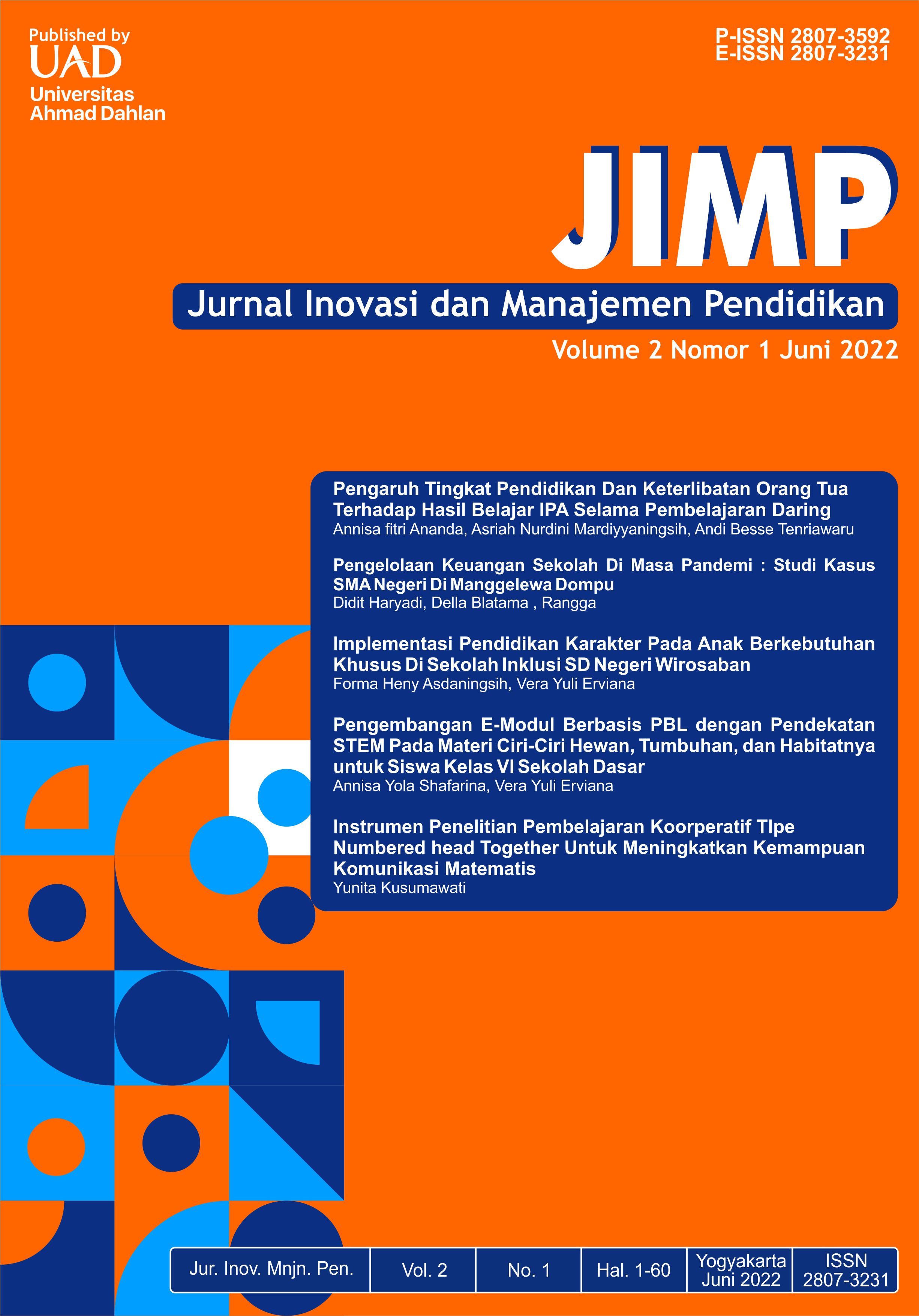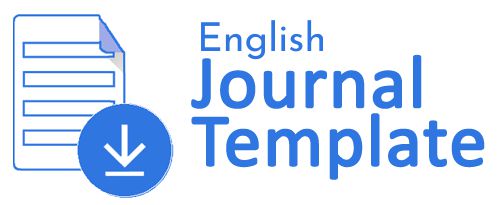Pengelolaan Keuangan Sekolah Di Masa Pandemi : Studi Kasus SMA Negeri Di Manggelewa Dompu
DOI:
https://doi.org/10.12928/jimp.v2i1.5208Abstract
Pada masa pandemi sekarang tentu sekolah harus lebih pintar mengelola karena masalah sekarang bukan saja masalah beberapa instansi tapi banyak Instansi banyak merasakan dampak dari pengelolaan keuangan pada masa pandemi ini. Adapun tujuan penelitian ini adalah (1) untuk melihat pengelolaan biaya investasi (2) untuk melihat pengelolaan biaya Personal (3) untuk melihat pengelolaan biaya Operasional di SMA Negeri 1 Manggelewa.
Penelitian ini merupakan penelitian Kualitatif dengan Pendekatan Studi Kasus. Alasan peneliti memilih studi kasus karena jenis pendekatan ini sangat cocok untuk menggambarkan keadaan dan situasi di SMA Negeri 1 Manggelewa yang merupakan tempat penelitian. Subjek pada penelitian ini adalah Kepala sekolah, Bendahara dan Beberapa guru yang bersedia untuk diwawancarai. Teknik pengumpulan data pada penelitian ini menggunakan wawancara dengan Triangulasi sumber. Teknik analisis dengan menggunakan Model Miles Huberman
Dari Penelitian dapat disimpulkan: (1) Biaya Investasi terkait gaji guru tidak ada perbedaan di SMA Negeri 1 Manggelewa baik sebelum pandemi dan masa pandemi pengembangan SDM juga sangat baik karena guru memanfaatkan IT untuk mendukung kegiatan pembelajaran pada masa pandemi ini (2) Biaya Personal terkait pembayaran yang dilakukan peserta didik terjadi perbedaan sebelum pandemi awalnya 60 Ribu dan masa pandemi ini 50 Ribu per bulan terjadi penurunan biaya terkait pembayaran peserta didik pada masa pandemi ini (3) biaya Operasional pada SMA Negeri 1 Manggelewa penggunaan yang paling banyak adalah penggunaan air dan kuota internet belajar. Penggunaan air di gunakan untuk mencuci tangan siswa dan kuota belajar untuk proses belajar.
References
Arikunto, Suharsimi.2010. Prosedur Penelitian suatu Pendekatan Praktik Edisi revisi. Jakarta. PT. Rineka Cipta.
Azhari, U. L., & Kurniady, D. A. (2016). Manajemen Pembiayaan Pendidikan, Fasilitas Pembelajaran, Dan Mutu Sekolah. Jurnal Administrasi Pendidikan, 23(2). https://doi.org/10.17509/jap.v23i2.5631
Bond, E., Dibner, K., & Schweingruber, H. (n.d.). Reopening K-12 Schools During the COVID-19 Pandemic : Prioritizing Health , Equity , and Communities. https://doi.org/10.17226/25858
Cresswell, John.2015. Penelitian Kualitatif dan Desain Riset. Yogyakarta: Pustaka Pelajar
Fattah.2000. Ekonomi dan Pembiayaan Pendidikan. Rosda. Bandung
Ferdi, W. P. (2013). PEMBIAYAAN PENDIDIKAN : SUATU KAJIAN TEORITIS FINANCING OF EDUCATION : A THEORITICAL STUDY. 565–578.
Lian, B., & Nopilda, L. (2018). (Jurnal Manajemen, Kepemimpinan, dan Supervisi Pendidikan) P-ISSN: 2548-7094 E-ISSN 2614-8021. 3(2).
Munir, A. (2013). Manajemen Pembiayaan Pendidikan dalam Perspektif Islam. Jurnal At-Ta’dib, 8(2), 232–234.
Murabahah, P. (2021). No Title. 3(1), 1–14.
Nafisah, D., Widiyanto, , & Sakitri, W. (2017). Economic Education Analysis Journal MANAJEMEN PEMBIAYAAN PENDIDIKAN DI MADRASAH ALIYAH Info Artikel. 6(3), 788–797.
Nurochim, S. N., Studi, P., & Pendidikan, M. (1907). KOMPLEKSITAS MODEL SEKOLAH ADAPTIF DI MASA. 16(1), 28–37. https://doi.org/10.23917/jmp.v16i1.11201
Permen No 69 tahun 2009 tentang Standar Pembiayaan
Permendikbud NO 8 Tahun 2020 tentang Juknis Bantuan Operasional
Rashid Ameer. 2010. Determinant of Corporate Hedgin Parctices in Malaysia. International Business Research 3(2):120-130.
S Najibullah. 2005. An Empirical Investigation of the Relationship Between Intellectual Capital and Firms. Journal Market Value and Financial Performance. University Bangladesh
Sd, D. I., Kota, N., & Aceh, B. (2012). PENGELOLAAN PEMBIAYAAN SEKOLAH. 1(2), 34–47.
Smk, D. I., & Pondok, Y. (2017). Disusun oleh : Agustian Mulyandari.
Sudarmono Sudarmono, Lias Hasibuan, K. A. U. (2013). Pembiayaan Pendidikan. Pendidikan Dan Kebudayaan, 4(1), 565–578.
UU No 14 pasal 13 Tentang Guru dan Dosen
UU No 20 Tahun 2003 Tentang sistem Pendidikan Nasional
Downloads
Published
How to Cite
Issue
Section
License
Copyright (c) 2022 Universitas Ahmad Dahlan

This work is licensed under a Creative Commons Attribution-ShareAlike 4.0 International License.
This article's copyright is transferred to Universitas Ahmad Dahlan (UAD) if and when the item is accepted for publication. The undersigned hereby transfers any rights in and to the paper including without limitation all copyrights to UAD. The undersigned hereby represents and warrants that the article is original and that he/she is the author of the paper, except for material identified as to its source, with permission notices from the copyright owners where required. The undersigned represents that he/she has the power and authority to make and execute this assignment.
We declare that:
This paper has not been published in the same form elsewhere.
It will not be submitted anywhere else for publication before acceptance/rejection by this Journal.
Copyright permission is obtained for materials published elsewhere and which require this permission for reproduction.
Furthermore, I/We hereby transfer the unlimited rights of publication of the above-mentioned paper in whole to UAD. The copyright transfer covers the exclusive right to reproduce and distribute the article, including reprints, translations, photographic reproductions, microform, electronic form (offline, online), or any other reproductions of similar nature.
The corresponding author signs for and accepts responsibility for releasing this material on behalf of any co-authors. This agreement is to be signed by at least one of the authors who have obtained the co-author(s) assent where applicable. After submission of this agreement signed by the corresponding author, changes of authorship or in the order of the authors listed will not be accepted.
Retained Rights/Terms and Conditions
Authors retain all proprietary rights in any process, procedure, or article of manufacture described in the Work.
Authors may reproduce or authorize others to reproduce the Work or derivative works for the author's personal use or company use, provided that the source and the UAD copyright notice are indicated, the copies are not used in any way that implies UAD endorsement of a product or service of any employer, and the documents themselves are not offered for sale.
Although authors are permitted to re-use all or portions of the Work in other works, this does not include granting third-party requests for reprinting, republishing, or different types of re-use.







